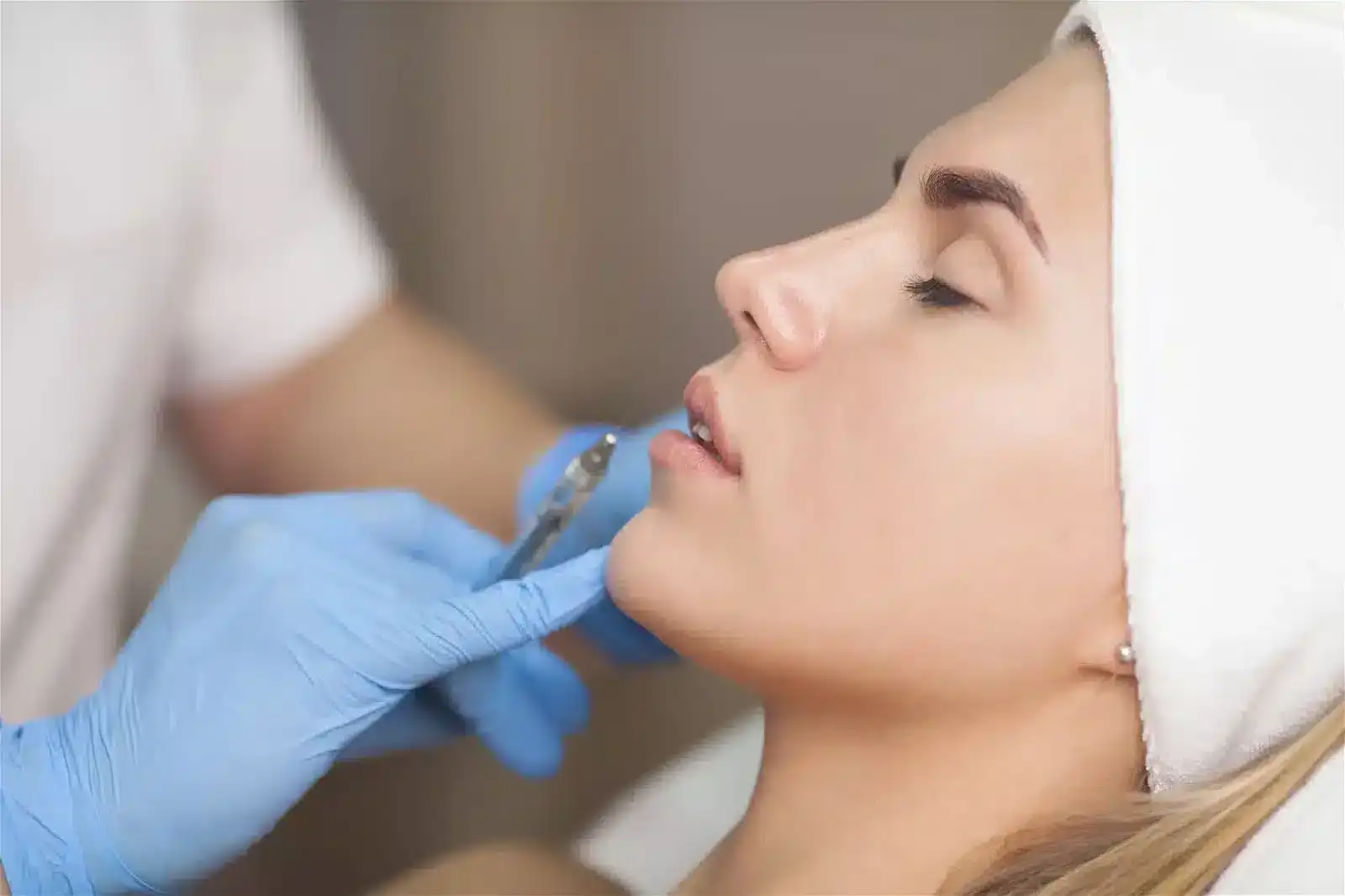
Dissolving Lip Fillers
David Fuller
Last Updated On: October 15, 2024
In the world of cosmetic enhancements, a new trend is gaining momentum as individuals seek a way to reverse the plumped and pouty look that lip fillers provide. The process of dissolving lip fillers, once a relatively obscure procedure, is now in the spotlight, drawing attention from those who have had fillers done and are now seeking a change. This article delves into the science behind the procedure and the reasons behind its growing popularity.
Why Do People Get Lip Fillers?
In recent years, the trend of getting lip fillers has surged in popularity, prompting questions about the reasons behind this cosmetic procedure. One of the primary motivations for getting lip fillers is to achieve a fuller and plumper lip aesthetic. Celebrities and social media influencers have significantly influenced this trend, often showcasing their enhanced lips on various media platforms. The desire for fuller lips is driven by wanting a more youthful and attractive appearance.
Furthermore, lip fillers are considered a non-surgical cosmetic procedure with minimal downtime, making them an attractive option for individuals seeking quick and relatively painless enhancements. Many people appreciate the convenience of lip fillers, which can be completed in a short office visit.
It’s important to note that while lip fillers can provide immediate results, they are not permanent, typically lasting anywhere from six months to a year. As a result, some individuals choose to undergo regular touch-up procedures to maintain their desired lip appearance. However, not everyone who opts for lip augmentation is happy with their new look.
Reasons for Dissolving Lip Fillers
One of the primary reasons people seek to dissolve lip fillers is dissatisfaction with the results of their previous procedure. Sometimes, individuals may find their lips unnatural or disproportionate after receiving lip fillers. This dissatisfaction can be due to overfilling or an uneven distribution of the filler substance.
Another common reason for seeking lip filler dissolution is the desire for a change in appearance. As trends evolve, some individuals may decide that fuller lips are no longer their preferred look and wish to return to their natural lip shape and size. Lip fillers dissolving allows them to reverse the augmentation and regain their original appearance.
Furthermore, there are instances where complications or side effects occur after receiving lip fillers. These can include lumps, bumps, asymmetry, or an allergic reaction to a lip filler. In such cases, individuals may opt to dissolve the fillers to alleviate these issues and restore their lip health.
The Science Behind Dissolving Lip Fillers
At the core of dissolving lip fillers is the action of an enzyme known as hyaluronidase. Naturally occurring in the human body, this enzyme plays a critical role in regulating hyaluronic acid levels, being a natural filler dissolver. When injected into the lips, it accelerates the degradation of the hyaluronic acid molecules within the filler, gradually restoring the lips to their pre-filler condition.
Hyaluronic acid is one of the key extracellular matrix components and is responsible for maintaining moisture and hydration. By binding to water molecules, hyaluronic acid creates a plumping effect, which is why it’s widely used in dermal fillers. When the need for a change arises, hyaluronidase steps in to reverse the process.
The Step-By-Step Process
Dissolving lip fillers is an exacting process requiring the expertise of trained medical professionals, often found in specialized cosmetic clinics. The procedure involves several key steps:
- Consultation: Before the procedure, patients consult with a practitioner to discuss their goals, assess the amount and type of filler used initially, and determine whether dissolving is a suitable option.
- Preparation: The practitioner cleanses the lip area and may apply a local anesthetic to decrease discomfort during the procedure.
- Injection: Hyaluronidase is injected into the lips at specific points using a fine needle. The enzyme begins to break down the hyaluronic acid in the filler immediately.
- Wait and Observe: Patients are typically advised to wait 24 to 48 hours to see the full effects of the treatment. Multiple sessions may be necessary to completely dissolve the filler, depending on the initial volume and type of filler used.
Benefits and Risks
One of the primary reasons behind the surge in interest in lip filler dissolution is the procedure’s reversibility. Unlike surgical interventions, which can be permanent and carry greater risks, dissolving fillers provide a non-invasive and relatively quick solution for individuals who want to return to their natural lip shape. It also serves as a corrective measure for those dissatisfied with their initial lip filler treatment results.
However, it’s essential to recognize that dissolving lip fillers isn’t entirely risk-free. Patients may experience side effects after dissolving a lip filler, like swelling and bruising at the injection sites. Additionally, there’s a possibility of uneven dissolving, which may require additional sessions for correction. It’s crucial to consult with a qualified practitioner to thoroughly discuss the procedure’s potential risks and benefits before undergoing treatment.
The Trend and Its Broader Implications
The rise of dissolving lip fillers is emblematic of the ever-shifting beauty industry. While the fascination with fuller lips endures, this trend showcases that beauty ideals are fluid, subject to change, and deeply personal. It underscores the importance of individual choice and customization in aesthetics.
As this trend keeps gaining momentum, it will have broader implications in the field of cosmetic enhancement. Beauty trends continually evolve, driven by societal influences, cultural shifts, and personal preferences. Dissolving lip fillers exemplifies the demand for flexibility in one’s appearance and the desire to adapt to changing beauty standards.
Moreover, the procedure’s non-permanence aligns with the contemporary view of beauty as an ever-changing form of self-expression. Individuals want to have the freedom to experiment and redefine their aesthetic goals without the constraints of irreversible alterations.
Conclusion
The rise of dissolving lip fillers shows us the evolving nature of cosmetic enhancements. People seek this procedure for various reasons, including dissatisfaction with results, changing their beauty preferences, or a need to address complications. Hyaluronidase is at the core of this process, gradually reversing the effects of lip fillers.
As beauty ideals continue to change, non-permanent solutions like lip filler dissolvers allow individuals to experiment with their looks as they see fit.
FAQ
How long do lip fillers take to dissolve?
Lip fillers typically take 24 to 48 hours to start dissolving after the injection of hyaluronidase, with complete dissolution potentially requiring multiple sessions depending on the initial amount and type of filler used.
Is it OK to dissolve a lip filler?
Yes, it is generally safe to dissolve lip fillers when the procedure is performed by a qualified medical professional using hyaluronidase. However, consulting a practitioner is essential to assess individual circumstances and potential risks.
Is dissolving lip fillers painful?
Dissolving a lip filler may cause mild discomfort or a stinging sensation during the procedure, but it is typically well-tolerated by most individuals. Topical numbing cream is often applied to minimize discomfort.
How to dissolve a filler without hyaluronidase?
Dissolving an already applied filler without use of hyaluronidase is challenging. The most common alternative method is natural enzymatic degradation over time, which regularly takes several months. A surgical lip filler removal procedure may be a viable option for certain cases, although it is undoubtably more invasive. For the consideration of such a procedure, consulting a qualified medical professional is essential for achieving the best outcome.
References
- Murray G, Convery C, Walker L, Davies E. Guideline for the Safe Use of Hyaluronidase in Aesthetic Medicine, Including Modified High-dose Protocol. J Clin Aesthet Dermatol. 2021;14(8):E69-E75.
- Jung H. Hyaluronidase: An overview of its properties, applications, and side effects. Arch Plast Surg. 2020;47(4):297-300. doi:10.5999/aps.2020.00752
- Czumbel LM, Farkasdi S, Gede N, et al. Hyaluronic Acid Is an Effective Dermal Filler for Lip Augmentation: A Meta-Analysis. Front Surg. 2021;8:681028. Published 2021 Aug 6. doi:10.3389/fsurg.2021.681028
- Ferraz RM, Sandkvist U, Lundgren B. Degradation of Hylauronic Acid Fillers Using Hyaluronidase in an In Vivo Model. J Drugs Dermatol. 2018;17(5):548-553.
Products
Cart
Log In
Newsletter
Subscribe for exclusive offers and updates on new arrivals
Share feedback at:
Working Hours
MON - SUN 9AM to 6PM EST
The Most Popular Brands
Med Supply Solutions
Support
Secure checkout is guaranteed with full adherence to PCI DSS payment standards.
Products listed here are guaranteed authentic and manufacturer-sourced.
Pay easily with trusted providers


Copyright 2025. Med Supply Solutions